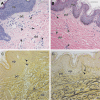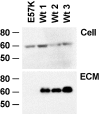Fibulin-4: a novel gene for an autosomal recessive cutis laxa syndrome
- PMID: 16685658
- PMCID: PMC1474103
- DOI: 10.1086/504304
Fibulin-4: a novel gene for an autosomal recessive cutis laxa syndrome
Abstract
Cutis laxa is a condition characterized by redundant, pendulous, and inelastic skin. We identified a patient with recessive inheritance of a missense mutation (169G-->A; E57K) in the Fibulin-4 gene. She had multiple bone fractures at birth and was diagnosed with cutis laxa, vascular tortuosity, ascending aortic aneurysm, developmental emphysema, inguinal and diaphragmatic hernia, joint laxity, and pectus excavatum by age 2 years. Her skin showed markedly underdeveloped elastic fibers, and the extracellular matrix laid down by her skin fibroblasts contained dramatically reduced amounts of fibulin-4. We conclude that fibulin-4 is necessary for elastic fiber formation and connective tissue development.
Figures




Similar articles
-
Fibulin-4 E57K Knock-in Mice Recapitulate Cutaneous, Vascular and Skeletal Defects of Recessive Cutis Laxa 1B with both Elastic Fiber and Collagen Fibril Abnormalities.J Biol Chem. 2015 Aug 28;290(35):21443-59. doi: 10.1074/jbc.M115.640425. Epub 2015 Jul 15. J Biol Chem. 2015. PMID: 26178373 Free PMC article.
-
Fibulin-5 mutations: mechanisms of impaired elastic fiber formation in recessive cutis laxa.Hum Mol Genet. 2006 Dec 1;15(23):3379-86. doi: 10.1093/hmg/ddl414. Epub 2006 Oct 11. Hum Mol Genet. 2006. PMID: 17035250
-
Altered TGFbeta signaling and cardiovascular manifestations in patients with autosomal recessive cutis laxa type I caused by fibulin-4 deficiency.Eur J Hum Genet. 2010 Aug;18(8):895-901. doi: 10.1038/ejhg.2010.45. Epub 2010 Apr 14. Eur J Hum Genet. 2010. PMID: 20389311 Free PMC article.
-
Cutis Laxa.Adv Exp Med Biol. 2014;802:161-84. doi: 10.1007/978-94-007-7893-1_11. Adv Exp Med Biol. 2014. PMID: 24443027 Review.
-
Autosomal recessive cutis laxa syndrome revisited.Eur J Hum Genet. 2009 Sep;17(9):1099-110. doi: 10.1038/ejhg.2009.22. Epub 2009 Apr 29. Eur J Hum Genet. 2009. PMID: 19401719 Free PMC article. Review.
Cited by
-
Genetic analysis of Pycr1 and Pycr2 in mice.Genetics. 2021 May 17;218(1):iyab048. doi: 10.1093/genetics/iyab048. Genetics. 2021. PMID: 33734376 Free PMC article.
-
Twenty patients including 7 probands with autosomal dominant cutis laxa confirm clinical and molecular homogeneity.Orphanet J Rare Dis. 2013 Feb 25;8:36. doi: 10.1186/1750-1172-8-36. Orphanet J Rare Dis. 2013. PMID: 23442826 Free PMC article.
-
Mechanisms of emphysema in autosomal dominant cutis laxa.Matrix Biol. 2010 Sep;29(7):621-8. doi: 10.1016/j.matbio.2010.06.005. Epub 2010 Jun 28. Matrix Biol. 2010. PMID: 20600892 Free PMC article.
-
Fibulin-4 regulates expression of the tropoelastin gene and consequent elastic-fibre formation by human fibroblasts.Biochem J. 2009 Sep 14;423(1):79-89. doi: 10.1042/BJ20090993. Biochem J. 2009. PMID: 19627254 Free PMC article.
-
Loss of ALDH18A1 function is associated with a cellular lipid droplet phenotype suggesting a link between autosomal recessive cutis laxa type 3A and Warburg Micro syndrome.Mol Genet Genomic Med. 2014 Jul;2(4):319-25. doi: 10.1002/mgg3.70. Epub 2014 Mar 11. Mol Genet Genomic Med. 2014. PMID: 25077174 Free PMC article.
References
Web Resource
-
- Online Mendelian Inheritance in Man (OMIM), http://www.ncbi.nlm.nih.gov/Omim/ (for OHS, ADCL, and ARCL)
References
Publication types
MeSH terms
Substances
Grants and funding
LinkOut - more resources
Full Text Sources
Other Literature Sources
Medical
Molecular Biology Databases

